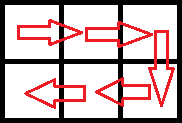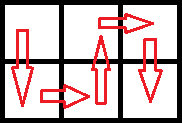Vasya's house is situated in a forest, and there is a mushroom glade near it. The glade consists of two rows, each of which can be divided into n consecutive cells. For each cell Vasya knows how fast the mushrooms grow in this cell (more formally, how many grams of mushrooms grow in this cell each minute). Vasya spends exactly one minute to move to some adjacent cell. Vasya cannot leave the glade. Two cells are considered adjacent if they share a common side. When Vasya enters some cell, he instantly collects all the mushrooms growing there.
Vasya begins his journey in the left upper cell. Every minute Vasya must move to some adjacent cell, he cannot wait for the mushrooms to grow. He wants to visit all the cells exactly once and maximize the total weight of the collected mushrooms. Initially, all mushrooms have a weight of 0. Note that Vasya doesn't need to return to the starting cell.
Help Vasya! Calculate the maximum total weight of mushrooms he can collect.
The first line contains the number n (1 ≤ n ≤ 3·105) — the length of the glade.
The second line contains n numbers a1, a2, ..., an (1 ≤ ai ≤ 106) — the growth rate of mushrooms in the first row of the glade.
The third line contains n numbers b1, b2, ..., bn (1 ≤ bi ≤ 106) is the growth rate of mushrooms in the second row of the glade.
Output one number — the maximum total weight of mushrooms that Vasya can collect by choosing the optimal route. Pay attention that Vasya must visit every cell of the glade exactly once.
3
1 2 3
6 5 4
70
3
1 1000 10000
10 100 100000
543210
In the first test case, the optimal route is as follows:

In the second test case, the optimal route is as follows:

比赛的时候没写出来,思路不清晰就没写出来,
赛后补题感觉这种题就是要思路清晰的时候写.
由于每个网格都必须经过一次,所以从左上角开始的路线只有两类:“↓→↑→↓→↑→” 折返以及在某一次往右时停止折返,一直往右直到最后一格,然后返回,一般的情况如下(也可能在第二行一直往右,到最后从第一行返回)
先做好预处理,就是先遍历所有从头开始,dfs就是实现这个东西.
接着预处理后缀和,之后就是从后面往前退,当然要判断一下奇偶.
1 #include <bits/stdc++.h> 2 #define ll long long int 3 #define inf 0x3f3f3f3f 4 #define N 400000 5 using namespace std; 6 int dis[3][2]={1,0,-1,0,0,1}; 7 ll n; 8 ll a[2][N],sum[N]; 9 int c[2][N]; 10 ll val[2][N],xn[2][N]; 11 bool vis[2][N]; 12 bool is(int x,int y){ return x>=0&&x<2&&y>=0&&y<n; } 13 void dfs(int x,int y,ll cc){ 14 vis[x][y] = true; 15 c[x][y] = cc; 16 for(int i=0;i<3;i++){ 17 int xx = x + dis[i][0]; 18 int yy = y + dis[i][1]; 19 if(is(xx,yy)&&!vis[xx][yy]){ 20 xn[xx][yy] = xn[x][y] + cc*a[x][y]; 21 dfs(xx,yy,cc+1); 22 } 23 } 24 } 25 26 int main(){ 27 scanf("%d",&n); 28 for(int i=0;i<2;i++){ 29 for(int j=0; j<n;j++){ 30 scanf("%lld",&a[i][j]); 31 sum[j] += a[i][j]; 32 } 33 } 34 for(int i=n-2;i>=0;--i) 35 sum[i] += sum[i+1];//后缀和 36 dfs(0,0,0); 37 int up,down; 38 if(n&1){ 39 up = n-1; 40 ll cc = c[0][up]; 41 val[0][up] = cc*a[0][up] + (cc + 1)*a[1][up]; 42 down = n-2; 43 cc = c[1][down]; 44 val[1][down] = cc*a[1][down] + (cc+1)*a[1][down+1] +(cc+2)*a[0][down+1] + (cc+3)*a[0][down]; 45 }else{ 46 up = n-2; 47 ll cc = c[0][up]; 48 val[0][up] = cc*a[0][up] + (cc+1)*a[0][up+1] + (cc+2)*a[1][up+1] + (cc+3)*a[1][up]; 49 down = n-1; 50 cc = c[1][down]; 51 val[1][down] = cc*a[1][down] + (cc+1)*a[0][down]; 52 } 53 54 for(int i = up; i>=2;i=i-2){ 55 ll cc = c[0][i-2]; 56 val[0][i-2] = val[0][i] - sum[i]*2; 57 val[0][i-2] += cc*a[0][i-2] + (cc+1)*a[0][i-1]; 58 cc += (n-i)*2 + 2; 59 val[0][i-2] += cc*a[1][i-1] + (cc+1)*a[1][i-2]; 60 } 61 62 for(int i = down; i>=2; i=i-2){ 63 ll cc = c[1][i-2]; 64 val[1][i-2] = val[1][i] - sum[i]*2; 65 val[1][i-2] += cc*a[1][i-2] + (cc+1)*a[1][i-1]; 66 cc +=(n-i)*2 + 2; 67 val[1][i-2] += cc*a[0][i-1] + (cc+1)*a[0][i-2]; 68 } 69 70 ll ans = 0; 71 for(int i=0;i<2;++i){ 72 for(int j=0;j<n;++j){ 73 if((i+j)%2==0){ 74 ans = max(ans,val[i][j]+xn[i][j]); 75 } 76 } 77 } 78 printf("%lld\n",ans); 79 return 0; 80 }